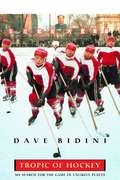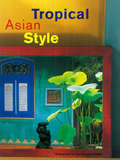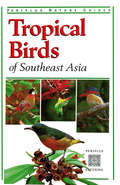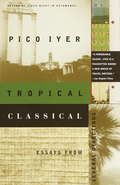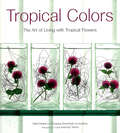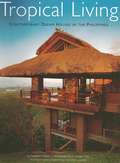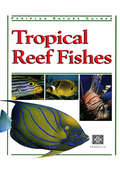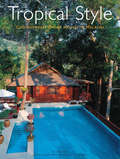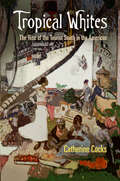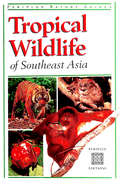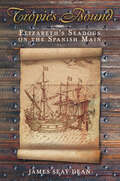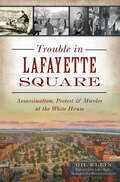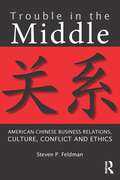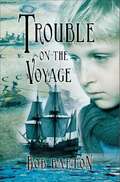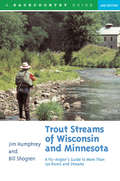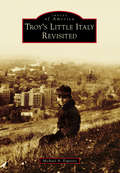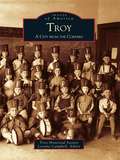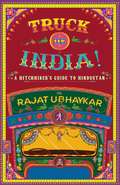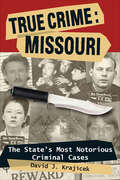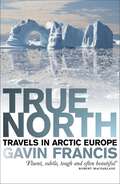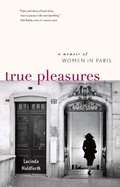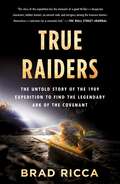- Table View
- List View
Tropic of Hockey: My Search for the Game in Unlikely Places
by Dave BidiniFrom Toronto to China, Dubai to Transylvania and back, a hilarious, moving account of one man's quest for "pure hockey."
Tropical Asian Style
by Luca Invernizzi Tettoni William WarrenTropical Asian Style contains over 400 colour photos by world-renowned photographer Luca Invernizzi Tettoni. Well-known architects, designers and authorities on Asia's cultural heritage provide insightful views on the houses and their design elements. A final section on tropical decorating provides helpful tips on selecting Asian fabrics, furniture and artifacts.
Tropical Birds of Southeast Asia
by Morten StrangeThis handy field guide is an excellent introduction to the fantastic array of birds found in Southeast Asia. This selection features 96 typical species and clearly describes their special characteristics. Many are easy-to-find birds adapted to living around cities and towns, while others can be seen in nature reserves. Illustrated with over 100 beautiful color photographs, showing the birds in their natural habitats, this book will delight both keen bird watchers and beginners alike. Over 100 full-color photographs Informative text Scientific and common names listed
Tropical Classical
by Pico IyerIn Tropical Classical the author of Video Nights in Katmandu and The Lady and the Monk visits a holy city in Ethiopia, where hooded worshippers practice a Christianity that has remained unchanged since the Middle Ages. He follows the bewilderingly complex route of Bombay's dabbawallahs, who each day ferry 100,000 different lunches to 100,000 different workers.Iyer chats with the Dalai Lama and assesses the books of Salman Rushdie and Cormac McCarthy. And he brings his perceptive eye and unflappable wit to bear on the postmodern vogues for literary puffery, sexual gamesmanship, and frequent-flier miles. Glittering with aphorisms, overflowing with insight, and often hilarious, Tropical Classical represents some of Iyer's finest work.From the Trade Paperback edition.
Tropical Colors
by Luca Invernizzi Tettoni Sakul Intakul Wongvipa Devahastin Na Ayudhya[In this stunning book, renowned Thai floral artist Sakul Intakul combines colorful tropical flowers, exotic foliage and other unusual design materials in refreshingly original floral displays suitable for any occasion and any setting. Photographed in the spectacular, contemporary homes of Thailand's leading artists, designers and professionals, the simple but imaginative floral displays evoke the essence of a modern Asian style.]This refreshingly original book goes beyond the everyday-elevating tropical flowers from mere floral arrangements to meditative floral "art installations" that serve as dramatic design centerpieces in contemporary tropical homes. Created from a combination of exotic and colorful tropical flowers, plant materials-fibers and leaves from the banana and coconut, twigs from the bamboo-and other less orthodox materials like wire netting, the arrangements harmoniously blend a strong, usually three-dimensional structure with the sweet and subtle elements of flowers. Allow Tropical Colors to inspire you, adding a gorgeous Asian flair to your home!
Tropical Constrained Environments and Sustainable Adaptations: Businesses and Communities (Managing the Asian Century)
by Simona Azzali K ThirumaranThis book investigates resource-constrained environments in the tropics and subtropics where people’s lives and businesses are affected, and adaptations occur periodically. Constrained environments are unique territories characterised by challenging circumstances, limited land and natural resources. They can be places with a small municipal boundary or cities in which parts around them may be consumed by ocean, bay or mountains. Those places face hard physical boundaries like coastlines and mountains, which in addition to policy decisions that may limit height or density, can also serve to limit capacity for expansion. Successful communities and businesses tend to survive in a changing environment given their strong intuitive and forward-looking adaptations.This book delves into the role of urban planning and design in the promotion of business and adaptations of people and communities. Additionally, the focus takes into account impact analysis and the effects of an expanding populations, including growing migrant flows, and business needs on the built environment of land-constrained territories
Tropical Hotels: Thailand Malaysia Singapore Java Bali
by Jacob Termansen Kim Inglis Pia Marie MolbechTropical Hotels showcases the best boutique hotels and resorts in Bali, Java, Singapore, Malaysia and Thailand. Southeast Asia is renowned the world over for its superb standards of resort architecture, hotel service and interior design. With over 300 ravishingly beautiful, full-color photographs, this book doubles up as a guidebook to fabulous places to stay and a treasure trove of interior design and architecture.
Tropical Living
by Elizabeth Reyes A. Chester OngStart with a warm tropical climate. Add an abundance of exotic natural building material. And then let the cross currents of Asian design and aesthetics create a rich architectural alchemy of it's own. The result? The exquisite homes of the Philippines, a perfect balance of form and functionality, beautifully portrayed in Tropical Living.
Tropical Nature: Life and Death in the Rain Forests of Central and (Zona Tropical Publications)
by Adrian Forsyth Ken MiyataSeventeen marvelous essays introducing the habitats, ecology, plants, and animals of the Central and South American rainforest.A lively, lucid portrait of the tropics as seen by two uncommonly observant and thoughtful field biologists. Its seventeen marvelous essays introduce the habitats, ecology, plants, and animals of the Central and South American rainforest. Includes a lengthy appendix of practical advice for the tropical traveler.
Tropical Reef Fishes
by Gerald AllenThis Periplus Nature Guide provides an excellent introduction to 68 of the most commonly encountered tropical reef fishes. Written by Dr. Gerald Allen, international authority on reef fishes, it features stunning color shots by some of the world's best underwater photographers.
Tropical Style
by Jacob Termansen Gillian BealTropical Style showcases thirty-five contemporary Malaysian homes and resorts that feature the use of vernacular cultural forms and cross-cultural influences in new and exciting ways. From modern minimalist homes in Kuala Lumpur to wooden houses set in lush garden settings and secluded coastal and island beach retreats, all the homes have been selected for their stunning design, originality of concept and innovative fusion of age-old architectural patterns with a modern aesthetic sense.
Tropical Whites
by Catherine CocksAs late as 1900, most whites regarded the tropics as "the white man's grave," a realm of steamy fertility, moral dissolution, and disease. So how did the tropical beach resort--white sand, blue waters, and towering palms--become the iconic vacation landscape? Tropical Whites explores the dramatic shift in attitudes toward and popularization of the tropical tourist "Southland" in the Americas: Florida, Southern California, Mexico, and the Caribbean. Drawing on a wide range of sources, Catherine Cocks examines the history and development of tropical tourism from the late nineteenth century through the early 1940s, when the tropics constituted ideal winter resorts for vacationers from the temperate zones. Combining history, geography, and anthropology, this provocative book explains not only the transformation of widely held ideas about the relationship between the environment and human bodies but also how this shift in thinking underscored emerging concepts of modern identity and popular attitudes toward race, sexuality, nature, and their interconnections.Cocks argues that tourism, far from simply perverting pristine local cultures and selling superficial misunderstandings of them, served as one of the central means of popularizing the anthropological understanding of culture, new at the time. Together with the rise of germ theory, the emergence of the tropical horticulture industry, changes in passport laws, travel writing, and the circulation of promotional materials, national governments and the tourist industry changed public perception of the tropics from a region of decay and degradation, filled with dangerous health risks, to one where the modern traveler could encounter exotic cultures and a rejuvenating environment.
Tropical Wildlife of Southeast Asia
by Alain Compost Jane WhittenThe rich array of natural ecosystems covering Southeast Asia nurture a spectacular variety of wildlife. This hand Periplus Nature Guide provides an excellent introduction to 86 of these fascinating species, many unique to the region. Written by Jane Whitten, an authority on Southeast Asian wildlife, this book combines a wealth of zoological information with stunning color photographs by renown wildlife photographer Alain Compost.
Tropics Bound: Elizabeth's Seadogs on the Spanish Main
by James Seay DeanFor the first time, and long awaited, we have the view from the gun deck of the wide world that opened to the Elizabethans on the Spanish Main and among the islands of the Caribbean. The tang of salt air stings the story. So does fearsome reality, the diseases and storms that wreaked havoc on sailors and ships alike and, more often than not, ruined the ambitions of many a financier. With the seapower of Imperial Spain still dominant, England’s private adventurers could “singe the beards” of the haughty Spaniards but wherever possible still evaded Iberian naval firepower and the dreaded Inquisition. Tropics Bound, rich in documentary research, reveals in triumph and failure the lives of privateers who deserve to be remembered – of wealth acquired, of health forsaken, and of risks so often surprisingly achieved.’
Trouble in Lafayette Square: Assassination, Protest & Murder at the White House (Landmarks)
by Gil KleinA unique history of the park across from the White House, and the many tumultuous events that have happened there—includes photos and illustrations. Lafayette Square, near the White House, has been in the spotlight during recent protests—but many are unaware that this Washington, DC, spot is surrounded by landmarks and steeped in a fascinating history of rebellion. A congressman shot and killed the son of Francis Scott Key in broad daylight on the square and got away with it. On the night Lincoln was assassinated, a co-conspirator forced his way into Secretary of State William Seward&’s house and nearly killed him. The women&’s suffrage movement created the tradition of White House protest that goes on to this day, and in 1950, Puerto Rican nationalists tried to force their way into Blair House to assassinate President Truman, who was living there. In this book, prominent Washington journalist Gil Klein recounts these and other stories, bringing to life the rich and sometimes bloody history of this seven-acre public gathering place.
Trouble in the Middle: American-Chinese Business Relations, Culture, Conflict, and Ethics
by Steven P. FeldmanThis book will help readers better understand the ethical and cultural assumptions that both American and Chinese business cultures bring to business relationships in China. It analyzes the relationships developed between the two cultures, areas where they conflict, and how these conflicts are (or are not) resolved. These relationships are investigated in three stages. The author: describes and interprets American business experience in China describes and interprets Chinese business experience in China, including interaction with Americans compares these two business cultures as they are experienced in China to investigate the relationships between them, centering the cultural analysis on ethical issues. Feldman's thorough research gets to the crux of how American and Chinese executives perceive the ethical and cultural aspects of doing business. The result is a book that will prove helpful to all those looking to expertly navigate Chinese-American business relationships.
Trouble on the Voyage
by Bob BartonA tiny speck imprisoned in a world of white… This is an exciting adventure novel told through the eyes of eleven-year-old ships boy Jeremy. It is both history and fiction. The merchant ship Henrietta Maria has been trapped in the ice of Hudson Strait for two months. It is August 6, 1631, when she finally breaks free to search for a northwest passage. The crew knows that it must leave Hudson Bay by early October to avoid being caught in the ice for the winter. The ship is leaking badly and the crew is ravaged by scurvy. Finally, Captain James announces that they cannot make it back to Hudson Strait before freeze-up. With half the crew suffering from scurvy and even lacking boots, will anyone survive in this cold and desolate place?
Trout Streams of Wisconsin and Minnesota: An Angler's Guide to More Than 120 Trout Rivers and Streams (Second Edition) (Trout Streams)
by Jim Humphrey Bill ShogrenThe definitive guide to this trout-fishing mecca, which includes several of Trout Unlimited's top 100 trout streams in the country. Wisconsin and Minnesota together boast more than 12,500 miles of designated trout waters in more than 3,000 streams. Thanks to conservation efforts by governmental and volunteer organizations, fishing is better than it has been in decades. In this completely updated and expanded second edition, the authors have added information on many new streams. Veteran anglers Humphrey and Shogren describe their native trout waters with an evocative sense of place that conveys not only the details but also the experience an angler can expect. Features include: profiles of more than 120 productive trout rivers and streams; information on hatches, access points, and wading conditions; travel directions, map references, and information on nearby facilities; 55 detailed maps; hatch charts for the region's major hatches; advice on tackle, flies, and tactic; local hatch charts and fly patterns; information on tackle shops and guide services; and much more.
Troy's Little Italy Revisited
by Michael A. EspositoA significant part of Troy's history, and that of its neighborhood, is the immigration of diverse ethnic groups. By 1900, the US Census reported 465 Italian-born residents in Troy, and in 1930, there were 2,000 Italian immigrants. From 1900 to the 1950s, Little Italy, bordering the central business district from Ferry Street to the Poestenkill and from Fourth Street to Prospect Park, was predominately an Italian or Italian American neighborhood. Among the close-knit families of Troy's Little Italy were import stores, 60 mom-and-pop shops, churches, schools, a community center, and a veterans' post, all of which were found within a 20-block radius. America's Little Italy neighborhoods became centers of ethnic culture and heritage. In the 1960s, urban renewal challenged Troy and other cities with mixed results. Today, there is resurgence in Troy, with plans to expand the city's central historic district to include most of Little Italy. In the meantime, empty nesters, artists, and young professionals are moving into the neighborhood as valuable community partners continue to support the efforts of the neighborhood group Troy Little Italy.
Troy: A City from the Corners
by Loraine Campbell Troy Historical SocietyLong before it was the site of shopping centers, corporate headquarters, and universities, Troy was a humble pioneer settlement comprised of farms and small knots of buildings at simple crossroads known as Troy Corners, Big Beaver, and Halsey Corners. School bells, church socials, and harvesting seasons punctuated the simple country lives of early Troy residents. The establishment of the Detroit United Railway in 1898 brought new opportunities to Troy settlers, rattling up Livernois daily and transporting passengers, milk, and freight between Flint and Detroit. By the end of World War II, Troy was rapidly changing. Subdivisions replaced farms, the township was incorporated as the City of Troy, and gracious homes and new businesses quickly replaced the clusters of clapboard structures. This book utilizes the remarkable resources of the Troy Historical Society and the Troy Museum & Historic Village to document and celebrate Troy's development over the course of two centuries.
Truck de India!: A Hitchhiker's guide to Hindustan
by Mr. Rajat Ubhaykar"The share auto I squeeze into next seems unusually vulnerable after a night in the truck - too compact, too low down. Perhaps, these are the usual side effects of prolonged riding with the king of the road, I think to myself. But it is only when I fill in ‘truck’ as my mode of transportation in the hotel ledger at Udaipur does the utter ludicrousness of my endeavour truly hit home" Think truck drivers, and movie scenes of them drunkenly crushing inconvenient people to their gravelly deaths come to mind. But what are their lives on the road actually like? In Truck De India!, journalist Rajat Ubhaykar embarks on a 10,000 km-long, 100% unplanned trip, hitchhiking with truckers all across India. On the way, he makes unexpected friendships; listens to highway ghost stories; discovers the near-fatal consequences of overloading trucks; documents the fascinating tradition of truck art in Punjab; travels alongside nomadic shepherds in Kashmir; encounters endemic corruption repeatedly; survives NH39, the insurgent-ridden highway through Nagaland and Manipur; and is unfailingly greeted by the unconditional kindness of perfect strangers. Imbued with humour, empathy, and a keen sense of history, Truck De India! is a travelogue like no other you've read. It is the story of India, and Indians, on the road.
True Crime: The State's Most Notorious Criminal Cases
by David J KrajicekComprehensive look into the dangerous world of glider warfare.
True North: Travels in Arctic Europe
by Gavin FrancisA journey through the far north from the Shetland Islands to Greenland and beyond: &“A wonder-voyage . . . often beautiful&” (Robert Macfarlane, author of Underland). The stark, vast beauty of the remote landscape of Arctic Europe has been the focus of human exploration for thousands of years. In this striking blend of travel writing, history, and mythology, Gavin Francis offers a unique portrait of the northern fringes of Europe. His journey begins in the Shetland Islands, takes him to the Faroes, Iceland, Greenland, Svalbard, and Lapland. Following in the footsteps of the area's early pioneers, the author observes how the region has adapted to the twenty-first century, offering insight into the lives of people he encounters along the way. As with all the best travel writing, True North is an engaging, compassionate tale of self-discovery, blending historical and contemporary narratives. &“His nuanced, often witty, observations of the people and places he encounters mean True North really gets under the skin of Europe&’s magical north.&” —Sunday Herald &“An evocative writer.&” —Booklist on Empire Antarctica
True Pleasures
by Lucinda HoldforthAt a turning point in her life, Lucinda Holdforth journeys to Paris and takes a very personal tour through the lives, loves, and losses of its most celebrated women. From Colette to Nancy Mitford, Marie Antoinette to Coco Chanel, Napoleon's Josephine to Edith Wharton, all were rule-breakers and style-setters. Utterly diverse, they shared one common passion: Paris. Exploring the city in their footsteps, Holdforth, and readers, gain inspiration from the women who created and nurtured the world's most civilized city.
True Raiders: The Untold Story of the 1909 Expedition to Find the Legendary Ark of the Covenant
by Brad RiccaTrue Raiders is The Lost City of Z meets The Da Vinci Code, from critically acclaimed author Brad Ricca.This book tells the untold true story of Monty Parker, a British rogue nobleman who, after being dared to do so by Ava Astor, the so-called “most beautiful woman in the world,” headed a secret 1909 expedition to find the fabled Ark of the Covenant. Like a real-life version of Raiders of the Lost Ark, this incredible story of adventure and mystery has almost been completely forgotten today.In 1908, Monty is approached by a strange Finnish scholar named Valter Juvelius who claims to have discovered a secret code in the Bible that reveals the location of the Ark. Monty assembles a ragtag group of blueblood adventurers, a renowned psychic, and a Franciscan father, to engage in a secret excavation just outside the city walls of Jerusalem.Using recently uncovered records from the original expedition and several newly translated sources, True Raiders is the first retelling of this group’s adventures– in the space between fact and faith, science and romance.
